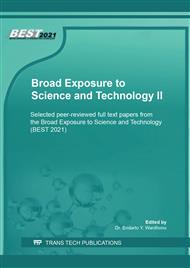[1]
S. T. Dwiyati, A. Kholil, R. Riyadi, and S. E. Putra, 2019, Influence of layer thickness and 3D printing direction on tensile properties of ABS material, J. Phys. Conf. Ser., 1402(6) 0–6.
DOI: 10.1088/1742-6596/1402/6/066014
Google Scholar
[2]
P. Alexander, S. Allen, and D. Dutta, 1998, Part orientation and build cost determination in layered manufacturing, CAD Comput. Aided Des., 30(5) 343–356, (1998).
DOI: 10.1016/s0010-4485(97)00083-3
Google Scholar
[3]
M. Taufik and P. K. Jain, 2013, Role of build orientation in layered manufacturing: A review, Int. J. Manuf. Technol. Manag., 27(1–3) 47–73.
Google Scholar
[4]
O. A. Mohamed, S. H. Masood, and J. L. Bhowmik, 2015, Optimization of fused deposition modeling process parameters: a review of current research and future prospects, Adv. Manuf., 3(1) 42–53.
DOI: 10.1007/s40436-014-0097-7
Google Scholar
[5]
E. Yasa, O. Poyraz, E. U. Solakoglu, G. Akbulut, and S. Oren, 2016, A Study on the Stair Stepping Effect in Direct Metal Laser Sintering of a Nickel-based Superalloy, Procedia CIRP, 45 175–178.
DOI: 10.1016/j.procir.2016.02.068
Google Scholar
[6]
I. Buj-Corral, A. Domínguez-Fernández, and R. Durán-Llucià, 2019, Influence of print orientation on surface roughness in fused deposition modeling (FDM) processes, Materials (Basel), 12(23).
DOI: 10.3390/ma12233834
Google Scholar
[7]
M. S. Alsoufi and A. E. Elsayed, 2017, How Surface Roughness Performance of Printed Parts Manufactured by Desktop FDM 3D Printer with PLA+ is Influenced by Measuring Direction, Am. J. Mech. Eng., 5(5) 211–222.
Google Scholar
[8]
Kovan V, Tezel T, Topal ES, and Camurlu HE, 2018, Printing Parameters Effect on Surface Characteristics of 3D Printed Pla Materials, Mach. Technol. Mater., 12(7) 266–269.
Google Scholar
[9]
L. Di Angelo, P. Di Stefano, and A. Marzola, 2017, Surface quality prediction in FDM additive manufacturing, Int. J. Adv. Manuf. Technol., 93(9–12) 3655–3662.
DOI: 10.1007/s00170-017-0763-6
Google Scholar
[10]
P. Sreedhar, C. MathikumarManikandan, and G. Jothi, 2012, Experimental Investigation of Surface Roughness for Fused Deposition Modeled Part with Different Angular Orientation, Int. J. Adv. Des. Manuf. Technol., 5(3) 21–28.
Google Scholar
[11]
N. Vidakis, M. Petousis, N. Vaxevanidis, and J. Kechagias, 2020, Surface roughness investigation of poly-jet 3D printing, Mathematics, 8(10) 1–14.
DOI: 10.3390/math8101758
Google Scholar
[12]
K. Kumar and G. S. Kumar, 2015, An experimental and theoretical investigation of surface roughness of poly-jet printed parts: This paper explains how local surface orientation affects surface roughness in a poly-jet process, Virtual Phys. Prototyp., 10(1) 23–34, (2015).
DOI: 10.1080/17452759.2014.999218
Google Scholar
[13]
H. S. Byun and K. H. Lee, 2005, Determination of the optimal build direction for different rapid prototyping processes using multi-criterion decision making, Robot. Comput. Integr. Manuf., 22(1) 69–80.
DOI: 10.1016/j.rcim.2005.03.001
Google Scholar
[14]
M. S. Alsoufi, M. W. Alhazmi, D. K. Suker, M. Yunus, and R. O. Malibari, 2019, From 3D models to FDM 3D prints: Experimental study of chemical treatment to reduce stairs-stepping of semi-sphere profile, AIMS Mater. Sci., 6(6) 1086–1106.
DOI: 10.3934/matersci.2019.6.1086
Google Scholar
[15]
L. Hiegemann, C. Agarwal, C. Weddeling, and A. E. Tekkaya, 2016, Reducing the stair step effect of layer manufactured surfaces by ball burnishing, AIP Conf. Proc., 1769 1–7.
DOI: 10.1063/1.4963612
Google Scholar
[16]
I. Gibson, D. Rosen, and R. Stucker, 2015, Additive Manufacturing Technologies., 2nd Ed. New York: Springer.
Google Scholar
[17]
V. D. Sagias, K. I. Giannakopoulos, and C. Stergiou, 2018, Mechanical Properties of 3D Printed Polymer Specimens, Procedia Struct. Integr., 10 85–90.
DOI: 10.1016/j.prostr.2018.09.013
Google Scholar


